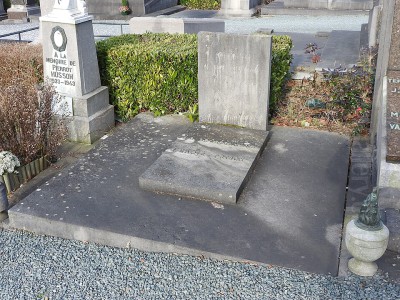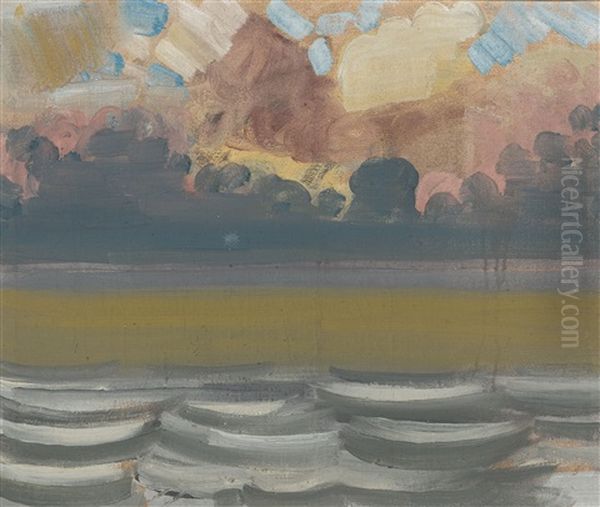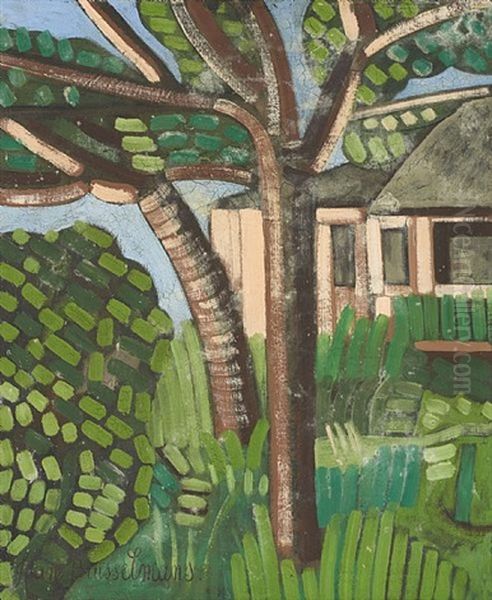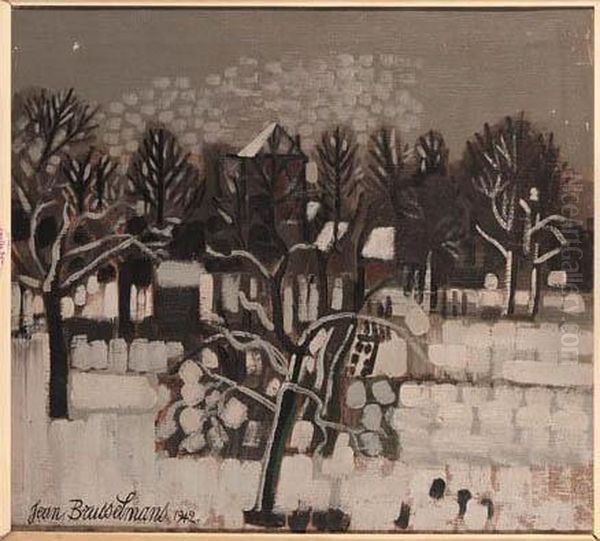
Jean Brusselmans stands as a significant yet often solitary figure in the landscape of 20th-century Belgian art. Born in Brussels in 1884 and passing away in Dilbeek in 1953, he navigated the turbulent currents of modernism, developing a highly personal and enduring visual language. Though associated loosely with Flemish Expressionism, Brusselmans carved his own path, marked by a distinctive blend of structural rigor, simplified forms, and a profound connection to the landscapes and everyday life of his native Belgium. His journey from a craftsman in lithography to a painter of unique vision, initially underappreciated but later celebrated, offers a compelling study in artistic independence and integrity.
Early Life and Artistic Formation
Jean Brusselmans' roots were firmly planted in Brussels, the city of his birth. His initial foray into the world of art was practical rather than purely academic. Before dedicating himself fully to painting, he gained foundational skills as a lithographer and engraver. This early experience with printmaking techniques likely instilled in him an appreciation for line, form, and the translation of three-dimensional reality onto a two-dimensional surface, elements that would subtly inform his later painterly practice.
At the age of fourteen, Brusselmans took a significant step by joining the Belgian Lithographers' Association. This early immersion provided him with valuable practical experience and exposure to the professional artistic milieu of the time. However, his ambition extended beyond the graphic arts. Seeking formal training, he enrolled at the prestigious Académie Royale des Beaux-Arts in Brussels. This period was crucial for his development, exposing him to academic traditions as well as the revolutionary ideas sweeping through European art at the turn of the century.

During his studies, Brusselmans absorbed the influence of major figures who were redefining painting. The structural innovations of Paul Cézanne, the systematic color theories of Georges Seurat, and the raw emotional power of Vincent van Gogh left their mark. He also engaged with the legacy of Belgian artists like the Symbolist James Ensor, whose unique blend of the grotesque and the beautiful was a powerful force in the local scene. Initially, his work reflected the prevailing trends, moving through phases of Realism and Impressionism, mastering the techniques of capturing light and atmosphere prevalent in the late 19th century.
A significant connection formed during his academy years was with Rik Wouters, a fellow student who would become a leading figure in Brabant Fauvism. The two artists even shared a studio for a time, fostering an environment of experimentation. Wouters' vibrant color and dynamic brushwork likely encouraged Brusselmans to explore more expressive avenues, pushing him beyond academic constraints and towards the bolder styles emerging across Europe, particularly French Fauvism led by artists like Henri Matisse.
Forging an Independent Path
While Brusselmans absorbed the lessons of Impressionism and Fauvism, he consciously resisted being fully assimilated into any single movement. His artistic temperament leaned towards structure and synthesis rather than purely spontaneous expression or the dissolution of form. He began to move away from the fleeting effects of light central to Impressionism and the purely arbitrary, emotive color of Fauvism. Instead, he started to build his compositions with a greater emphasis on underlying geometry and simplified, solid forms.
His style evolved towards what could be described as a highly personal form of Post-Impressionism, deeply indebted to Paul Cézanne's constructive brushwork and emphasis on the underlying architecture of nature. Brusselmans began to flatten space, define objects with clear outlines, and use blocks of color to build volume and structure. This approach marked a departure from many of his Belgian contemporaries and set him on a distinct trajectory.
He developed a unique aesthetic characterized by its apparent simplicity and profound underlying order. His paintings often feature strong horizontal and vertical lines, creating a stable, almost architectural framework. Within this structure, he arranged simplified shapes – houses, fields, trees, figures, or objects in a still life – with a keen sense of rhythm and balance. His color palette, while often bright and clear, was used less for emotional impact (as in Fauvism) and more for its formal properties, creating harmonious or deliberately contrasting relationships across the canvas.

This independence meant that Brusselmans never fully aligned himself with the dominant force in Belgian modern art of the time: Flemish Expressionism. While he shared the era and nationality with key figures like Constant Permeke, Gustave De Smet, and Frits Van den Berghe, his artistic aims differed. Flemish Expressionism often emphasized earthy tones, distorted forms, and a raw, sometimes angst-ridden depiction of rural life and human struggle. Brusselmans, while also depicting rural scenes, sought a greater sense of order, clarity, and formal harmony, filtering reality through a more rational, constructive lens. He remained an individualist, an "artist's artist," admired by peers but detached from collective manifestos.
The Influence of Cézanne and Matisse
The impact of Paul Cézanne on Jean Brusselmans' art cannot be overstated. He absorbed Cézanne's fundamental lesson: painting was not merely about imitating nature, but about constructing a parallel reality on the canvas using color and form. Brusselmans adopted Cézanne's method of representing volume and space through modulated planes of color, where adjacent patches define form rather than traditional light and shadow. This is evident in the way Brusselmans structures his landscapes and still lifes, breaking them down into distinct, often geometric, areas of color.
From Henri Matisse and the Fauves, Brusselmans likely drew inspiration for using color more boldly and expressively than the Impressionists. While he didn't adopt the wild, arbitrary color juxtapositions of pure Fauvism, he embraced brighter palettes and flatter applications of paint. He understood color's ability to create rhythm and define space independently of naturalistic representation. His paintings often feature large, unmodulated areas of color, contributing to their directness and decorative quality, yet always integrated within his strong compositional framework.
However, Brusselmans synthesized these influences into something uniquely his own. He tempered Cézanne's rigorous analysis with a certain Belgian sensibility, perhaps a greater connection to the specific textures and atmosphere of his local environment. He also restrained the potential decorative excess of Fauvism with his inherent preference for solidity and structure. His work finds a balance between observation and abstraction, representation and formal construction.
Other influences also played a role. The clarity and precision sought by some Constructivist artists, and perhaps even the objective approach of architects like Le Corbusier, may have resonated with Brusselmans' desire for order and essential forms. He studied the Old Masters in Brussels' museums, grounding his modern explorations in a deep understanding of pictorial tradition. This blend of influences – from Post-Impressionism and Fauvism to Constructivist ideas and historical painting – allowed him to create a visual language that was both modern and deeply personal.
Themes of Landscape and Still Life

Jean Brusselmans found his primary inspiration in the world immediately around him, particularly the rural landscapes of the Pajottenland region near Brussels, where he settled in Dilbeek. This area, with its rolling hills, patchwork fields, farmhouses, and distinctive Brabant light, became his enduring subject. He painted it repeatedly, not with the aim of capturing fleeting atmospheric effects, but of distilling its essential structure and character.
His landscape paintings, such as the notable Payottenland (1938), exemplify his mature style. He simplifies the scene into bold, interlocking shapes representing fields, sky, and buildings. Colors are applied in flat planes, often with strong outlines, emphasizing the two-dimensional pattern of the composition. Perspective is often flattened or tilted, creating a sense of immediacy and decorative unity. He wasn't interested in topographical accuracy but in conveying the rhythm, solidity, and quiet monumentality of the countryside.
Still life was another major genre for Brusselmans. He depicted humble, everyday objects – bowls, vases, fruit, vegetables, simple furniture – arranged on tabletops. These compositions allowed him to focus purely on formal relationships: the interplay of shapes, colors, and lines. He treated these ordinary items with the same seriousness and structural rigor as his landscapes, elevating them beyond mere representation. The objects become actors in a carefully orchestrated visual drama, their forms simplified and arranged to create a harmonious and balanced whole.
Figures also appear in his work, often integrated into landscapes or interiors. Works like Peasant woman with cap (1948) show his ability to simplify the human form, treating it as another element within the overall composition, defined by strong contours and planes of color. There's often a sense of stillness and introspection in his figures, reflecting the quiet, contemplative nature of his art.
During times of turmoil, like the war years, Brusselmans explored elemental themes. Paintings titled Fire, Clouds, and Rain suggest a deeper engagement with the forces of nature and perhaps the fragility of existence. Even here, however, his approach remained largely formal, translating these powerful phenomena into structured compositions of color and shape, seeking an underlying order even amidst potential chaos.
Life in Dilbeek: Solitude and Dedication
In 1924, Jean Brusselmans and his wife, Marie-Leen Fris, moved from the bustling environment of Brussels to the quieter, semi-rural setting of Dilbeek. This move marked a significant shift in his life and arguably reinforced his artistic independence. Living somewhat removed from the main art centers and their associated cliques allowed him to focus intensely on his own vision, free from the pressures of conforming to trends or seeking constant validation from the established art world.
His life in Dilbeek was characterized by dedicated work and a relatively simple existence. His wife, Marie-Leen, was a constant source of support, both emotionally and practically, often providing encouragement and understanding for his artistic endeavors. Their stable relationship provided a foundation upon which he could build his demanding artistic practice. He was known to be deeply passionate and sometimes intense about his work, reflected in an anecdote about him destroying one of his own paintings in a moment of frustration or dissatisfaction – a testament to his high standards and complex relationship with his creations.
This relative isolation, however, also contributed to his lack of widespread recognition during his lifetime. While respected by a circle of artists, critics, and collectors, he did not achieve the fame of some of his contemporaries. He wasn't a prolific self-promoter and seemed content to pursue his artistic questions in the relative quiet of his studio and the surrounding Pajottenland landscape. His focus remained steadfastly on the act of painting itself, on resolving the formal problems that fascinated him.
Despite his distance from the mainstream, Brusselmans did participate in some exhibitions and received occasional recognition. He exhibited work and reportedly received praise at the Belgian pavilion of the Paris International Exposition in 1937. He also undertook commissions, such as creating wall paintings for the 1935 Brussels World Fair. These instances show he was not entirely disconnected, but his primary commitment was to his personal artistic exploration rather than career advancement in the conventional sense. His life in Dilbeek fostered the concentration and consistency that define his oeuvre.
Artistic Style: Structure, Color, and Rhythm
The hallmark of Jean Brusselmans' mature style is its powerful sense of structure. He approached his subjects – whether landscape, still life, or figure – with an eye for their underlying geometric essence. Forms are simplified, reduced to their essential shapes, and often delineated by strong, dark outlines. This creates a clear separation between elements and emphasizes the compositional architecture of the painting.
His compositions are typically built upon a grid of horizontal and vertical lines, lending them stability and a sense of enduring order. He often employed flattened or multiple perspectives, tilting tabletops or landscapes towards the viewer, prioritizing the two-dimensional pattern on the canvas over illusionistic depth. This approach aligns him with modernist principles that assert the flatness of the picture plane.
Color in Brusselmans' work is crucial, but used in a specific way. He favored clear, often bright hues applied in flat, unmodulated planes. This technique reinforces the flatness of the composition and emphasizes the decorative quality of the surface. His color choices were not necessarily naturalistic; instead, he selected colors for their ability to create harmony, contrast, and rhythm across the canvas. He explored the relationships between colors, how they interact when placed side-by-side, contributing to the overall structure and visual impact.
Rhythm is another key element. The repetition of shapes, the interplay of lines, and the arrangement of color areas create a distinct visual cadence in his paintings. There is a deliberate, almost musical quality to the way he organizes the elements within the frame. This emphasis on rhythm and formal arrangement, rather than overt emotional expression, distinguishes his work from the more turbulent canvases of many Expressionists. His paintings possess a quiet intensity, derived from their rigorous construction and carefully balanced components.
While influenced by movements like Post-Impressionism, Fauvism, and potentially Constructivism or Cubism in its emphasis on geometry, Brusselmans' style remains resolutely individual. He synthesized these influences into a coherent and personal language that feels both modern and timeless, grounded in observation but transformed through a powerful formal intelligence. His work achieves a unique balance between representation and abstraction, capturing the essence of his subjects through a highly structured and visually compelling aesthetic.
Posthumous Recognition and Legacy
During his lifetime, Jean Brusselmans remained something of an outsider figure in the Belgian art scene. While he exhibited periodically and had admirers, he never achieved widespread fame or commercial success comparable to artists like Constant Permeke or René Magritte. His commitment to his unique artistic path, coupled with his somewhat withdrawn life in Dilbeek, meant his work circulated primarily within a limited sphere.
However, the decades following his death in 1953 saw a gradual but significant reassessment of his contribution to modern art. Starting tentatively in the 1960s, curators, critics, and collectors began to recognize the strength, originality, and enduring quality of his work. His paintings, once perhaps seen as too austere or idiosyncratic, were increasingly appreciated for their formal rigor, their unique synthesis of influences, and their quiet power.
A major turning point came later, particularly from the 1990s onwards. Increased scholarly attention and retrospective exhibitions brought his work to a wider audience, both in Belgium and internationally. A landmark event was the large-scale retrospective held in Ostend in 2011, which firmly established his importance. Another significant exhibition took place at the Gemeentemuseum (now Kunstmuseum Den Haag) in The Hague in 2018, further solidifying his reputation beyond Belgium's borders.
These exhibitions highlighted the consistency and depth of his artistic vision. They showcased his mastery of composition, his sophisticated use of color, and his ability to imbue ordinary scenes with a sense of monumentality and timelessness. His unique position – connected to Flemish Expressionism yet distinct from it, influenced by French modernism but deeply rooted in his Belgian environment – became clearer and more appreciated.
Today, Jean Brusselmans is recognized as one of the key figures of Belgian modernism. His work is seen as an important bridge between various artistic currents of the early 20th century. His dedication to formal principles, his structural clarity, and his unique "constructive" approach continue to resonate. He is no longer considered a marginal figure but an essential voice, an artist whose singular vision enriched the artistic landscape of his time and continues to offer rewards to viewers today.
Market Value and Collections
Reflecting his posthumous rise in critical acclaim, the market value of Jean Brusselmans' work has seen considerable growth, particularly since the turn of the 21st century. While his paintings were not highly sought after during his lifetime, increased recognition from institutions and collectors has driven demand and prices upward. Sources indicate a significant price increase trend after 2000, with one report mentioning a 32% rise in his price index for the year 2017 alone.
His works appear regularly at auction, primarily in Belgium, but also attracting interest from collectors in neighboring countries like France and the Netherlands. Auction results vary depending on the period, size, subject matter, and quality of the work. Specific examples cited include the oil painting De Lente having an estimate of €5,600 in a 2017 sale, and Oostende (1937) being estimated at €6,000 around the same period. These figures likely represent smaller or less significant works.
For major canvases from his mature period, particularly his sought-after Pajottenland landscapes or significant still lifes, estimates and sale prices can be substantially higher. Some market reports have cited a general estimate range of €200,000 to €500,000 for top-tier works, reflecting the peak of market interest or exceptional examples coming to auction. This wide range underscores the variability common in the art market, but clearly indicates that Brusselmans is now considered a valuable and collectible artist.
His paintings are held in numerous important public collections, primarily in Belgium and the Netherlands. Key institutions include the Royal Museums of Fine Arts of Belgium in Brussels, the Groeningemuseum in Bruges, the Museum of Fine Arts Ghent (MSK), and the Kunstmuseum Den Haag in The Hague. The presence of his work in these major museums confirms his established place within the canon of Belgian and European modern art. Works like Peasant woman with cap (1948), once in private collections like that of J. Komkommer and exhibited at venues like the Palais des Beaux-Arts in Brussels, now often reside in or are sought by public institutions, ensuring their accessibility for study and appreciation.
Conclusion: A Singular Vision
Jean Brusselmans carved a unique and significant niche within the complex tapestry of 20th-century European art. A Belgian painter deeply connected to his native landscape, he navigated the influences of Impressionism, Fauvism, and the structural lessons of Cézanne to forge a highly personal style. Characterized by geometric rigor, simplified forms, flat planes of resonant color, and a profound sense of rhythm, his work stands apart from the mainstream of Flemish Expressionism, favoring clarity and construction over overt emotional turmoil.
His dedication to depicting the everyday world – the fields of the Pajottenland, the humble objects of a still life – imbued his subjects with a quiet monumentality. He was an artist concerned with the fundamental problems of painting: how to translate the three-dimensional world onto a two-dimensional surface, how to build form with color, and how to create harmony and order within the picture frame. His relative isolation in Dilbeek fostered an intense focus and consistency in his output.
Though underappreciated during much of his lifetime, Brusselmans' artistic integrity and the compelling quality of his work led to significant posthumous recognition. Major exhibitions and growing market appreciation have solidified his status as a key figure in Belgian modernism. His paintings, held in important museum collections, continue to engage viewers with their unique blend of observation, abstraction, and formal intelligence. Jean Brusselmans remains a testament to the power of a singular artistic vision pursued with unwavering dedication. His legacy is that of a painter who found profound beauty and enduring structure in the familiar world around him, translating it into a timeless visual language.